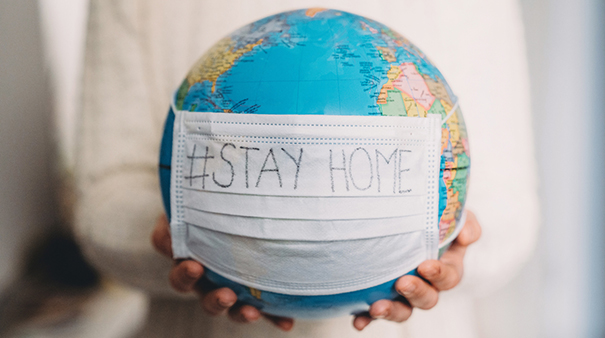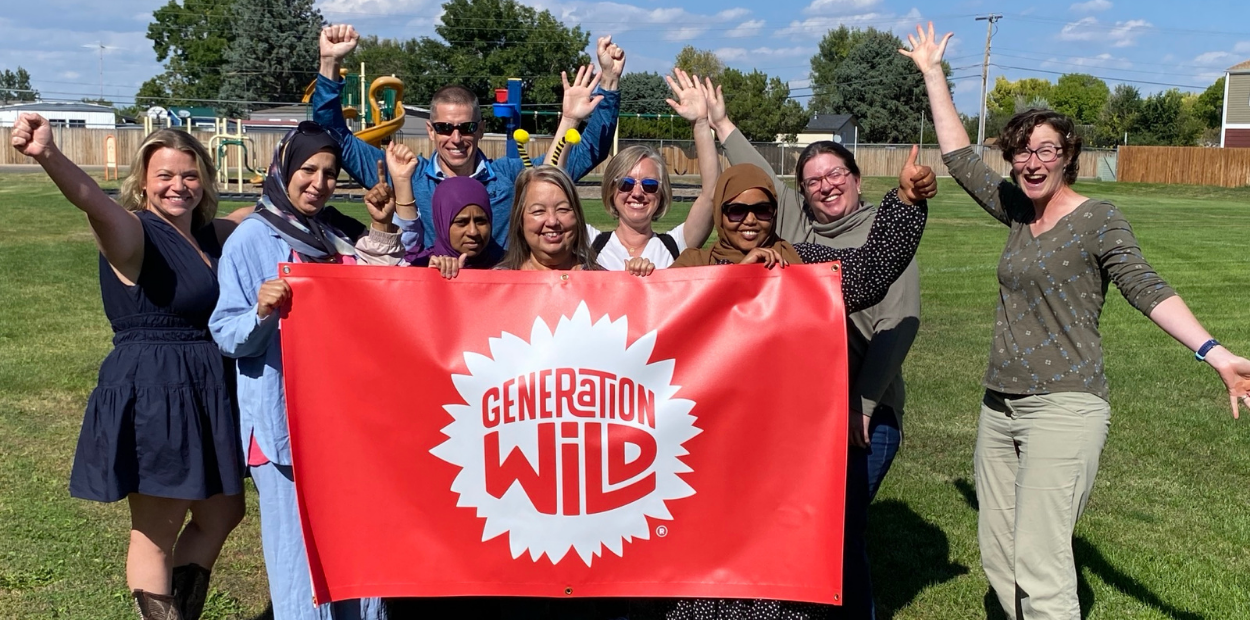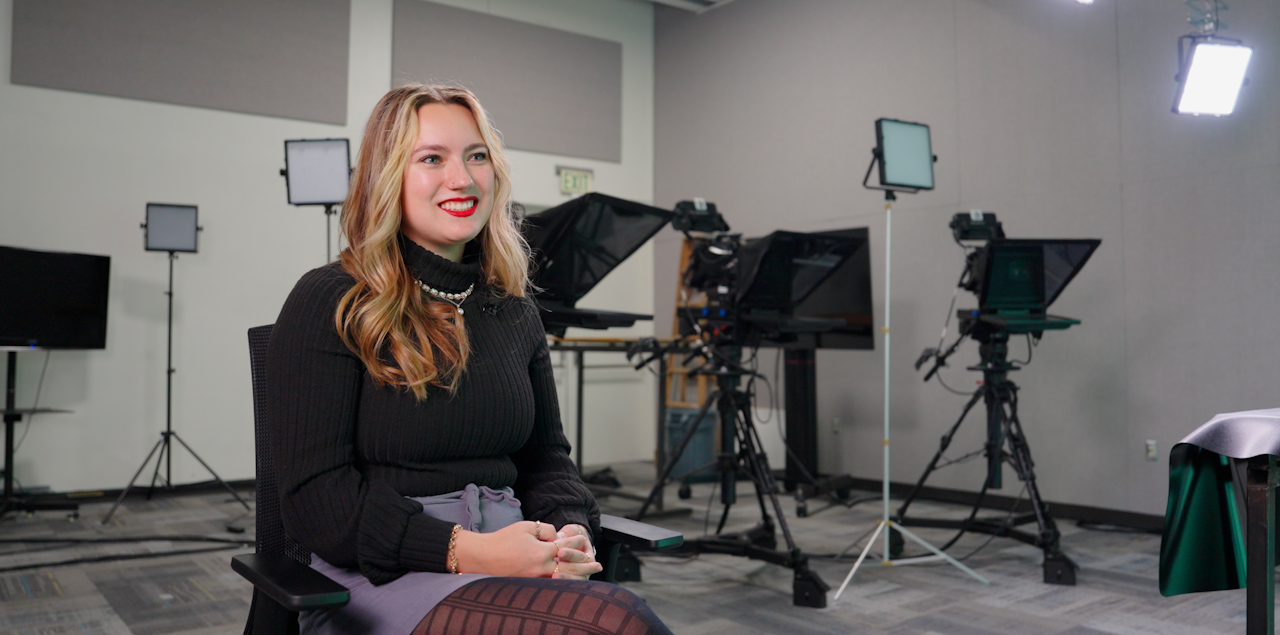
Article
February 25, 2021
Student Wins Scholarship with Essay on COVID-19 and Climate Change
UNC senior Emmy Scott was awarded a $5,000 scholarship for winning first place in Clearway Community Solar's 2020 Essay Contest Scholarship.
Emmy Scott, a senior double-majoring in Environmental and Sustainability Studies and Business Administration Management and minoring in Communication Studies at the University of Northern Colorado, was awarded a $5,000 scholarship for winning first place in Clearway Community Solar’s 2020 Essay Contest Scholarship.

Scott, who is also the grant coordinator for UNC’s Student LEAF organization, wrote an essay titled, “Crisis! The Relationship between COVID-19 and Climate Change,” that looks at how the ongoing COVID-19 pandemic has impacted climate-change efforts.
“The main message of my essay was that no matter how much we want things to return ‘back to normal’ from the tragic events that occurred during 2020 (Breonna Taylor, George Floyd, global fires and floods displacing millions), we can see that our ‘normal’ wasn’t working; instead of going backwards, we now have our chance to create a new normal,” Scott said. “It’s been a great experience and an even greater feeling to see my work published for others to read.”
Read her winning essay below:
Crisis! The Relationship between COVID-19 and Climate Change
By Emmy Scott
“I wish things were back to normal again”, a phrase that’s become quite popular in the last year. With rising cases in roughly 215 countries, stay-at-home orders put in place to control the spread of COVID-19 have been testing people’s physical and mental health. Isolation and drastic change has left people longing to return to their normal lives before the virus spread –but what exactly was our normal? Over the past 50 years, the “normal” has been a trend toward a 2% increase in global temperate (National Climate Assessment 2014). This increase will result in climate change which will bring a rise in sea level causing extreme hurricanes, floods, and other natural disasters that will destroy homes and businesses. The temperature rise will also create droughts making water-scarce and cultivating difficult.
Then, the abuse of natural resources from human activity will result in resource scarcities worldwide (NASA, 2020). Over 1,300 independent scientific studies concluded that there is more than a 95% probability that human activity has contributed to climate change (National Climate Assessment 2014).
At the start of the global pandemic, there seemed to be positive impacts on the environment. With less to no people outside, china’s air pollution improved, rivers in Italy cleared up, and there was a reduction in carbon emissions around the world (Kumari & Toshniwal, 2020). There was a decline in greenhouse gas emission, outdoor air pollution, environmental noise level, and land and wildlife pressure (Patrício Silva et al., 2021). Showing us that our normal lives are the main contributors to the crisis of climate change. Still, while outside air pollution was going down, other pollutants began causing harm to the environment (Patrício Silva et al., 2021).
One of the main pollutants caused by COVID-19 is the extreme increase in personal protection equipment (masks, gloves, face shields, etc.). The increase in large is due to the products being used by first responders and everyday people with no slowing in sight. For example, to provide citizens worldwide with the necessary amount of personal protection equipment (PPE) we would need roughly 129 billion face masks and 65 billion gloves monthly (Patrício Silva et al., 2021). Most PPE is also made up of nonwoven synthetic polymers such as polyethylene, polypropylene (PP), and polyethylene terephthalate (PET) –all of which contain plastic (Patrício Silva et al., 2021). Such plastics can take hundreds to thousands of years to decompose, in the meantime, the plastics break up into smaller and smaller pieces called microplastics (National Climate Assessment 2014).
PPE disposed of today is already creating a “never-ending-story” of plastics in our land and water. The nonwoven synthetic fibers were the main derivation of micro-plastic found in both water and sediment samples in the Magdalena River in Columbia (Patrício Silva et al., 2021). A UCL Plastic Waste Innovation report regarding mask use found that the use of reusable masks that could be washed had the lowest contribution to climate change, and reduced mask waste by 95% (Patrício Silva et al., 2021). Unfortunately, surgical masks and gloves are recommended not to be worn longer than a few hours and should be adequately disposed of to avoid cross-contamination; therefore, reusable masks aren’t an option for first responders.
The recommendation is necessary for the medical industry, but the increased use of PPE soon became accompanied by an increase in other single-used-plastics that degrade into microplastics. Reusable products such as metal straws, canvas bags, and bamboo silverware can be used in public spaces to replace single-use products offered. Yet with COVID-19, the fear of contamination has led to more institutions: restaurants, markets, schools, offices, etc.: refusing to use reusable materials that could potentially spread COVID-19. Also, several U.S. states have stopped recycling programs with concerns of the virus spreading if recycling is not sanitized and handled properly (Patrício Silva et al., 2021). Long-term, a pause in recycling could potentially harm the global momentum towards better recycling programs even after the pandemic has been controlled.
For consumers, safety concerns related to shopping in public have led to a preference for fresh-food being packaged in plastic containers to avoid food contamination (Dcnewton, 2020). The demand for plastic packaging is expected to increase by 40% with a 17% increase in other single-use plastic, including medical products. Still, it hasn’t been proven that reusable products accompany any more risk of spreading the virus than shoes or disposable gloves (Patrício Silva et al., 2021). Other than an increase in irreversible plastic waste in the environment, the longterm effects of reusable products being seen as “unsafe” to use during COVID-19, is the notation that nonsingular-use products are dirty. The COVID-19 pandemic could change what people think about using reusable products in public spaces forever.
Conclusively, to dispose of PPE and other possible containments, countries have been supporting incineration and landfilling which creates air, land, and water pollution. While some regions will be able to dispose of medical waste with alternative methods, minimizing some of the environmental risks, others with less waste management resources may be forced to utilize inappropriate strategies resulting in adverse effects on the environment (Patrício Silva et al., 2021). Incineration, for example, releases greenhouse gasses (GHGs) and other potentially hazardous compounds (heavy metals, dioxins, polychlorinated biphenyl [various chlorinated mixtures], and furans [contains carbon]) into the air (Patrício Silva et al., 2021). COVID-19 has taken the lives of over 1 million people; air pollutants caused by human activity are responsible for over 6 million deaths worldwide and counting (Patrício Silva et al., 2021 and WHO, 2020). By ignoring the risks and externalities of increasing plastic use and disposing of it in unsustainable ways, we have also increased the risks of pollutants in our air, water, and land.
Overall, the COVID-19 pandemic has shifted the world’s focus away from the climate change crisis. Public safety pressures have resulted in less and less attention from governmental agencies, the scientific community, and the general public. The distress of COVID-19 spreading has put new and ongoing climate change mitigation strategies on pause for both businesses, public institutions, governments, and individuals. New York, for example, pushed back their statewide ban on single-use plastic to January 2021. While other states such as Massachusetts went as far as banning the use of reusable shopping bags to minimize the risk of contamination to workers and customers (Patrício Silva et al., 2021).
Furthermore, it’s hindered the progress of companies switching to more eco-friendly business practices. Businesses are not just increasing their use of single-use products for safety, with the uncertainty of COVID-19 affects they are also becoming unwilling to spend more on sustainable practices (WHO, 2020). Face-to-face restriction, concerns of safety in public settings, and an increase in job-loss have led to less shopping worldwide. With fewer people out traveling, shopping, going to work, school, or visiting friends, the economy has seen high rates of job loss, furloughs, and businesses having to close their doors.
Worldwide, the International Monetary Fund predicts COVID-19 will reduce growth rates by 4% leading to a global recession (Kumari & Toshniwal, 2020). The global increase in job loss and stay-at-home regulations have left businesses, organizations, and institutions in terrifying positions. COVID-19 has forced the closure of 60% of business across the U.S. Leaving business owners, as well as employees, with a significant financial burden (Sundaram, 2020). Nonprofit organizations have seen an 83% reduction in revenue and over 50% have closed their doors as well (Independent Sector, 2020). The decline of nonprofits is worth mentioning because most of the organizations identified as human service organizations, allies, and supporters in the fight for environmental and human rights (Independent Sector, 2020). Also, stay-at-home orders have impacted schools which are obstructing lower and higher education learning.
The stay-at-home orders are in place to guard us, but having to enforce them has reinforced inequality and inequity for historically underrepresented populations (Dcnewton, 2020). Communities of color and low-income groups have been disproportionately impacted by the economic effects of COVID-19 (Dcnewton, 2020). Renters -many of them being people of color, low-income, or have job insecurity in the face of an epidemic- with less economic resources and less recovery support, are especially susceptible to risks such as displacement during any crisis (Ramirez, 2020). If we combine that with the fact that there are more renters in the U.S. than homeowner’s a risk of extreme displacement emerges (Ramirez, 2020). In just the United States, COVID-19 threatens 30-40 million renters with the risk of eviction (Benfer, Gilman, Edmonds, Butler, & Robinson, 2020). The displacement being caused by the virus is only a preview of what could happen if the climate crisis continues. The natural disasters, droughts, and resource scarcity brought on by climate change will result in millions of people having to move from their homes to survive the effects of climate change (NASA, 2020).
As climate change worsens, it’s predicted that the extreme natural disasters (floods, hurricanes, tornadoes, droughts, etc.) will destroy more businesses, homes, and schools, or displace people due to resource scarcity (NASA, 2020). Also, similar to trying to protect public health during the COVID-19 crisis, stay-at-home orders could be put back in place if the climate crisis is not solved, but this time it would be to protect us from the pollution in the air created by us –such as the greenhouse gases we’ve produced. While COVID-19 is rightfully a pressing matter, without mitigating our global impact on the environment and mending the damage already created, we could see a similar or even worse drop in the economy than what COVID-19 has created (Kumari & Toshniwal, 2020).
Although it is not all bad, with the similarities between COVID-19 and the climate crisis, we can turn the tragedy of COVID-19 into a blueprint for preparing for climate change. For one, the crisis has taught us that we cannot sit back and wait for change; we have to create it. In the COVID-19 crisis, we saw this in the way people reinvented working, learning, and living from the same distance. Similarly, for the climate crisis actions towards mitigation, we will need to change how we work, learn, and live. To reverse the damage created over the past 50 years, we will have to be innovative and adapt to change –just as we have been during the COVID-19 crisis.
Navigating through the COVID-19 has also shown us that in times of crisis it is not just about moving quickly, being unified is critical. The climate crisis is an urgent matter, but without unity, effective solutions will be difficult to reach. In the U.S. the politicization of wearing a mask showed how the division between people can shift focus away from what is important, our health. When we are united, we can create unimaginable change: such as converting the world almost completely online or discovering multiple effective vacations to a devastating virus within less than a year. To solve a crisis as major as climate change, we will need to be unified in how we’ve been at times during COVID-19. Strategies that consider intersectionality (the links between disasters, health, equity, racial disparities, and community investment) and put human and environmental rights at the forefront can create long-term solutions (Ramirez, 2020). Solutions that create more resilient and equitable places to live, resulting in a future that solves the crisis of climate change.
The current pandemic has also shown us strategies that could be used to protect individuals impacted by the effects of climate change. Stimulation packages and pandemic unemployment for furloughed employees have helped elevate the economic impacts of the virus –a plan of action that would be necessary to alleviate the economic effects of an increase in natural disasters. Similar to COVID-19, it will important for governments to create plans to protect businesses from climate change impacts. Forgivable loans, payroll tax relief, help with employee healthcare costs, and program grants are strategies being used that could help if climate change worsens -92% of a diverse group of business owners suggested forgivable loans are the most helpful to keep their companies afloat (Independent Sector, 2020).
As mentioned, with a combination of economic stress and a high percentage of the world not owning property, global displacement will arise. Policies and regulations that protect renters from eviction have been implemented during the beginning of COVID-19, showing us that an important step to the global crisis is displacement policies and the protection of low-income communities. Anti-displacement plans should be put together by multiple diverse agencies. Antidisplacement is important to keep the economy flowing, ensure public health and safety, and minimize financial burdened for businesses (Ramirez, 2020). Anti-displacement plans would include countries’ promoting healthy development growth, restricting divestment in underrepresented communities to provide security for renters, low-income, or those who may lose their jobs due to climate change effects, and support of refugee programs. As we’ve learned from COVID-19, a displacement plan will be necessary.
COVID-19 has devastated the economy, environment, and people’s lives. What began as a health crisis quickly progressed into an economic, social, and environmental threat. COVID-19 brought an increase in pollution, adverse effects on our air, water, and resources, as well as financial burdens, and an increase in displacement. Aid for the pandemic has cost the United States trillions of dollars. With the predictions of climate change being similar to the effects brought by COVID-19: an increase in pollution, adverse effects on our air, water, and resources, as well as financial burdens, and an increase in displacement: climate change has the potential of costing over trillions of dollars (NASA, 2020). This is why I mentioned the innovation of our everyday activities as the first step to be learned from COVID-19, as well as unity next. To minimize the economic cost of displacement and financial relief, cohesive change of our everyday activities will be necessary to attempt to reverse the damage we have already created.
Without the steps we have taken worldwide to mitigating COVID-19: unifying, working quickly for a solution, finding innovative ways to adapt to the crisis, and protecting financially vulnerable individuals or those with fewer resources: gaining control of the spread of the virus may have never been possible. For our safety and well-being, we must take similar steps to prepare for the climate crisis or reverse the damage we have already created quickly. To keep the economy afloat, schools in sessions and society flowing, we cannot go back to normal. Our “normal” has been leading us into the biggest crisis of our lifetimes, climate change. With a unified plan of action, we can design a new normal. Together, we can create a more adaptable, equitable, resilient, and thriving World.
Works Cited
- Benfer, E., Gilman, S., Edmonds, L., Butler, S., & Robinson, D. (2020, September 16). The COVID-19 Eviction Crisis: An Estimated 30-40 Million People in America Are at Risk. Retrieved December 19, 2020, from https://www.aspeninstitute.org/blog-posts/the-covid19-eviction-crisis-an-estimated-30-40-million-people-in-america-are-at-risk/).
- Dcnewton. (2020, April 15). The Dark Side of Environmentalism: Ecofascism and COVID-19. Retrieved December 19, 2020, from
https://usfblogs.usfca.edu/sustainability/2020/04/15/the-dark-side-of-environmentalismecofascism-and-covid-19/ - Independent Sector. (2020, June 15). The Impact of COVID-19 on Large and Mid-Sized Nonprofits. Retrieved December 19, 2020, from https://independentsector.org/resource/covid19-survey/
- Kumari, P., & Toshniwal, D. (2020, October 16). Impact of lockdown on air quality over major cities across the globe during COVID-19 pandemic. Retrieved December 19, 2020, from https://www.sciencedirect.com/science/article/pii/S2212095520304387
- NASA (2020, August 21). The Effects of Climate Change. Retrieved December 19, 2020, from https://climate.nasa.gov/effects/
- National Climate Assessment. (n.d.). Retrieved December 19, 2020, from https://nca2014.globalchange.gov/
- Patrício Silva, A., Prata, J., Walker, T., Duarte, A., Ouyang, W., Barcelò, D., & Rocha-Santos, T. (2021, February 1). Increased plastic pollution due to COVID-19 pandemic: Challenges and recommendations. Retrieved December 19, 2020, from https://www.ncbi.nlm.nih.gov/pmc/articles/PMC7430241/
- Ramirez, M. (2020, September 25). Research: Displacement in the Face of Climate Change. Retrieved December 19, 2020, from https://www.nrdc.org/experts/marissaramirez/research-displacement-face-climate-change
- Sundaram, A. (2020, December 11). Yelp data shows 60% of business closures due to the coronavirus pandemic are now permanent. Retrieved December 19, 2020, from https://www.cnbc.com/2020/09/16/yelp-data-shows-60percent-of-business-closures-dueto-the-coronavirus-pandemic-are-now-permanent.html
- WHO. WHO Coronavirus Disease (COVID-19) Dashboard. Retrieved December 19, 2020, from https://covid19.who.int/



